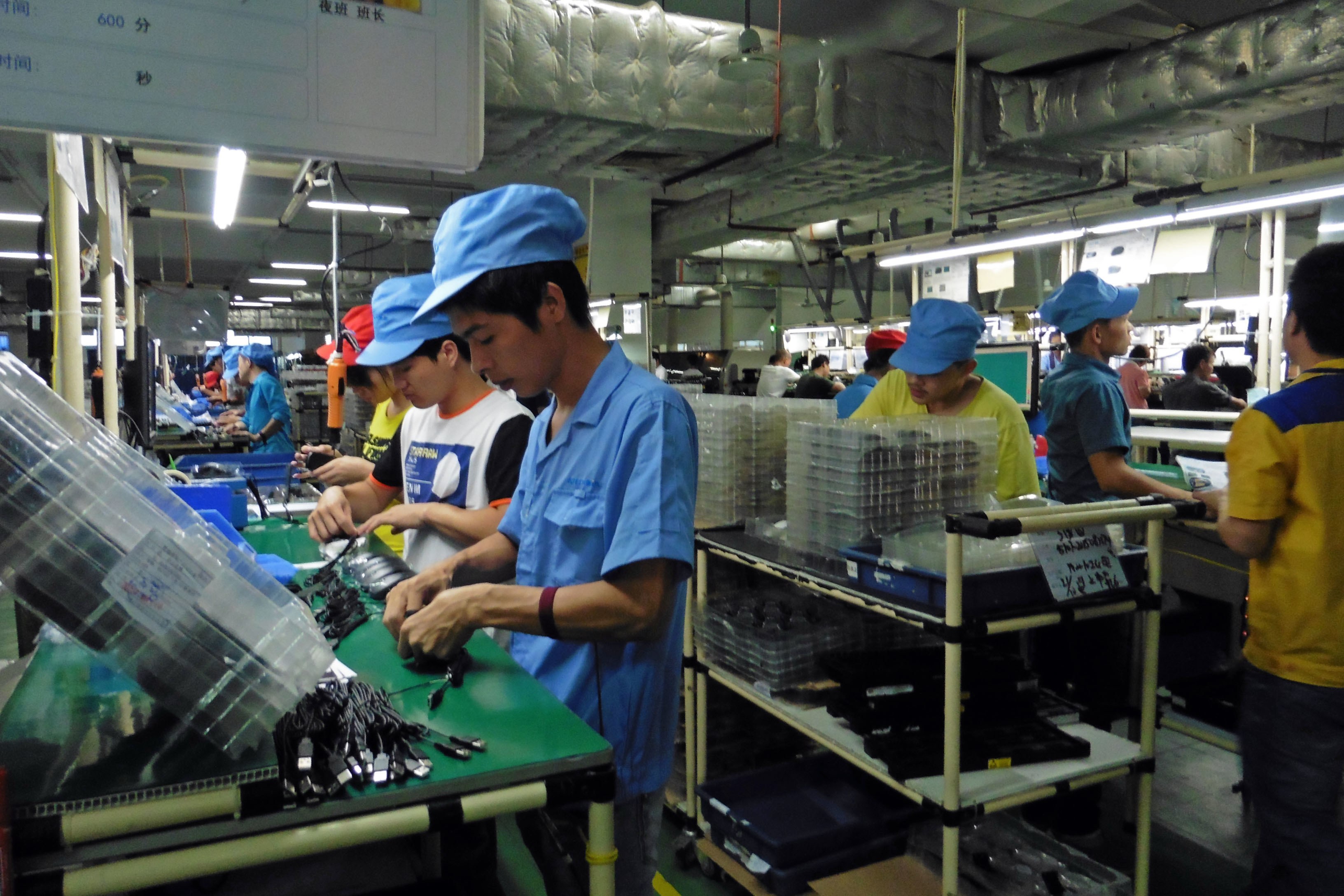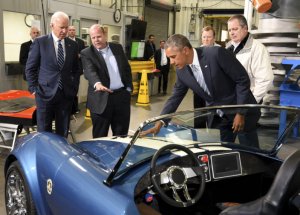Richard Vague looks at what it’ll take for the U.S. to win the R&D race
This article was originally published in Democracy
In 1787, in his capacity as secretary of the Pennsylvania Society for the Encouragement of Manufactures and the Useful Arts, [Tench] Coxe had provided support for a British emigrant, Andrew Mitchell, to return to Britain and pirate textile technology [then one of the world’s preeminent industries], a scheme that failed when Mitchell was discovered and forced to flee to Copenhagen. Thomas Digges smuggled nearly two dozen British textile workers to the United States, including some hired by [Alexander] Hamilton. In another case, an English weaver named George Parkinson was granted a US patent on textile technology [that had been developed in Britain] in 1791; later he went to work for the government-sponsored manufacturing center sponsored by Hamilton . . . Secretary of State Thomas Jefferson, in charge of patent policy, arranged for the patent. . . . In 1787, Phineas Bond, the British consul in Philadelphia, bought four carding and spinning machines that had been smuggled into the United States and sent them back to Britain.
In its earliest years, the United States took ideas from Britain, the birthplace of the Industrial Revolution and the keeper of those manufacturing secrets that had fueled its powerhouse textile industry. By 1872, America’s economy had surpassed that of Britain, and it soon became the world’s most creative industrial power, with eager scouts from other shores trekking to its factories. By 1918, America’s economy was larger than that of Britain, France, and Germany combined.
China, in the small handful of decades since it embraced capitalism, has aggressively sought to acquire intellectual property (IP) from the rest of the world. Witness just one unhappy Wall Street Journal headline: “How China Systematically Pries Technology From U.S. Companies: Beijing leans on an array of levers to extract intellectual property—sometimes coercively.”
Some commentators have accused China of stealing intellectual property, and characterized theirs as a copycat culture not well suited for innovation. In 2011, the journalist Alexandra Harney wrote that:
[T]he harder Beijing pushes its companies and scientists to come up with new ideas, the more they seem to copy the work of others. . . . In a nation with such breakneck economic growth and an overburdened judicial system the dishonest frequently win. The system to protect the honest simply isn’t robust enough. Dishonest copiers move quickly to secure an advantage in a rapidly growing market, and their success, in turn, perpetuates China’s copycat culture.
In 2016, Peter Guy, a financial writer and former international banker, argued that “copying and reverse engineering [in China] accelerated new product launches, but eroded China’s competitiveness. Stealing intellectual property has enormously benefited Chinese companies. But, it has crippled their ability to develop the next version or innovate. Just look at almost every important technological innovation in hardware, software, and the internet. Without sounding arrogant or imperialistic, they are with few exceptions made in America.”
China has assiduously and relentlessly copied others. In fact, in joint ventures that U.S. companies have entered into with Chinese companies, and in investments Chinese companies have made in U.S. and other foreign companies, the Chinese have often made the turnover of IP to China a requirement.
Yet China is doing far more than copy, steal, extract, and imitate. It is hell bent on taking over the world’s leadership in innovation, and is well on track to accomplish this. China’s President Xi Jinping has made indigenous innovation a national priority, and technology innovation and advancement are integral to China’s current five-year plan. In its 2006 National Medium-and Long-Term Program for Science and Technology Development, and in the speeches of its government leaders, China has made clear its goal of becoming an “‘innovative nation’ by 2020, an international leader in innovation by 2030, and a world powerhouse of scientific and technological innovation by 2050.” The business press is beginning to note this shift, as with CNN reporter Matt Rivers’s 2018 article, “Inside China’s Silicon Valley: From copycats to innovation.”
On top of this, in 2015, Chinese Premier Li Keqiang announced the Made in China 2025 initiative, an industrial policy that seeks to make China dominant in global high-tech manufacturing. This was seemingly modeled on the German government’s adoption in 2013 of its Industry 4.0 strategy, designed to significantly enhance the computerization of Germany’s already highly advanced manufacturing capability.
The bald truth is that China has crafted a focused, aggressive plan to dominate the most important areas of scientific and technological innovation, and its government is investing heavily to achieve that plan. In contrast, the U.S. government has invested at a (relatively) diminishing pace, leaving the United States vulnerable to being surpassed. In fact, if the United States doesn’t assertively respond, this will readily happen.
Breakthroughs Abound, on 5G and More
The numbers speak for themselves. In 2014, China awarded 34,000 PhDs in the natural sciences and engineering, as compared to 40,000 in the United States. More telling, China awarded 1.4 million undergraduate degrees in the natural sciences and engineering, almost four times as many as the 377,000 awarded in the United States. And while the number of these degrees has been increasing in both countries, that growth has been far faster in China. In ten years, PhDs awarded in China have increased by 146 percent as compared to 55 percent in the United States. China increasingly boosts its rate with expanded scholarship support, particularly for degrees like pharmaceutical science.
One result has been that China now leads the world in scientific papers published, with 426,000 studies in 2016 as compared to 409,000 in the United States. According to the World Intellectual Property Organization (WIPO), China is now the second largest source of international patent applications behind the United States and “is projected to overtake the U.S. within three years as the largest source of applications filed under WIPO’s Patent Cooperation Treaty.” It already leads the world in digital communications patent applications.
Many academics question the validity of China’s achievements, especially as it relates to the comparative quality and scientific rigor of these papers and degrees. They note, for example, that many Chinese engineering degrees are not of the same caliber as U.S. degrees, and that some Chinese scientific publications pay authors for research papers, whereas U.S. journals do not. They also note the evidently greater number of instances in China where authors have falsified scientific results. A study by Wei Quan at Wuhan University, Bikun Chen at Nanjing University of Science and Technology, and Fei Shu at McGill University was reported on by MIT Technology Review, which found that “plagiarism, academic dishonesty, ghost-written papers, and fake peer-review scandals are on the increase in China, as is the number of mistakes…The number of paper corrections authored by Chinese scholars increased from two in 1996 to 1,234 in 2016, a historic high, they say.”
Still, examples of Chinese innovation and genuine breakthroughs abound:
China produces more electric cars than anywhere else in the world, and it is already the world’s leader in battery technology, leading The Financial Times to headline one article from September 2018, “Why the future of electric cars lies in China: Tesla grabs the limelight, but the real story is elsewhere.”
China has also built more houses and office buildings than any other country in the past decade, and its construction technology now leads the world. A case in point is its prefabrication technology. In 2010, it startled the world when it demonstrated the construction of a 15-story hotel in less than a week using prefabricated materials (igniting a collateral debate about quality and safety). Low-income countries throughout Africa and elsewhere are proving to be a growing export market for this type of construction.
Chinese progress is just as pronounced in the most highly complex arenas. CRISPR-Cas9 is an astonishing new technology that can be used to edit genes within organisms. It holds seemingly unlimited promise (and risk) as a tool for enabling cures for diseases and for modification of life forms. Though developed in the United States, there is now more experimentation in China using this new technology than there is here at home, thanks to the greater availability of government funding and a more liberal regulatory environment. Dr. Carl June of the University of Pennsylvania, who is the leading immunotherapy researcher in the world and an early user of CRISPR, has stated, “We are at a dangerous point in losing our lead in biomedicine [to China].”
In addition, China aims to take the lead in artificial intelligence (A.I.). It envisions a $1 trillion A.I. industry, as CNBC reported in May 2018. Its investors injected $4.5 billion into more than 200 A.I. companies in China between 2012 and 2015. Nicholas Colas of DataTrek Research recently wrote: “Artificial intelligence, and especially the A.I. that powers visual analytics, is a critical technology for a raft of new products. The Western companies have their own advantages, to be sure. But the Chinese model of government sponsorship and private capital is coming on very strong.”
Just as notable is the lead China may already have in the race for 5G, the next generation of mobile communications, according to a U.S. National Security Council memo. As the memo states, 5G is “by no means simply a faster 4G . . . [but instead is] a change more like the invention of the Gutenberg Press.” As The Financial Times noted, with its much larger capacity for data, significantly reduced lag times, and greatly enhanced speeds, 5G is expected to extend well beyond phones and permeate every aspect of factories, automobiles, smart homes, robots, and more.
Beyond that, The New York Times reports, “China has a clear lead in [the computing discipline of] quantum encryption. As it has with other cutting-edge technologies, like artificial intelligence, the Chinese government has made different kinds of quantum [computing] research a priority.” This will be a crucial advantage in a world in which data security is an increasing concern.
The country is arguably already the global leader in high-tech manufacturing as well. The United States simply does not have the ready skills in place to manufacture certain smartphones at the scale on which they are built in China. High-tech manufacturing, as opposed to more routine manufacturing, commands higher profit margins and is itself a platform for product innovation.
Winning the R&D Race
To a degree not widely appreciated, scale alone can drive innovation. The bigger the market, the more opportunity there is for innovation, and the more necessity there is for it as well. With a larger number of customers than its competitors, a given company can invest more in R&D for product enhancements, will get more feedback from customers that can result in improvements in such products, and has more need for product modifications and production improvements to handle this larger number of customers. Amazon makes more delivery innovations than other retailers not only because it can, but because it has to.
In the mid- to late-1800s, for instance, the United States was simply building far more railroads, telegraphs, and guns than Britain and Germany—and that was the point when U.S. innovation in these areas overtook the world. China has now reached that point for an increasing number of products and services. Those who dismiss China as a mere copycat miss this aspect of the comparison. At a certain size, Chinese companies face challenges and opportunities that no one else has ever faced. At that point, it is hard not to be innovative. On top of this, small innovators are more likely to try and sell their innovations to the largest companies because that brings a greater profit potential. For example, a small A.I. startup company, most likely cash-starved but nurturing a new, unproven, but potentially powerful A.I. product that it has invented, will usually seek to sell itself to a larger company at the point when its product starts to gain market acceptance. Most often, the potential buyers will be the largest companies in that field. Increasingly, and in a rising number of sectors, those companies are Chinese.
The situation is clear. Both by desire and necessity, China already is a world-class innovator, despite how it’s often depicted. One byproduct of this is the increasing number of scientists from the United States and other countries relocating to China because of the increasing availability of financial support.
That’s not to minimize the daunting political and economic challenges China faces. And who is to begrudge it? The issue is not whether the Chinese are trying to rapidly advance. They are. The issue is how rapidly the United States is trying to advance, and whether it is maintaining its lead over China. It appears that it is not.
The concern regarding China “systematically pr[ying] technology” from U.S. companies is valid, with recurring headlines about Chinese hacking of U.S. government and corporate secrets, or U.S. criminal charges against Chinese intelligence officers. It is certainly the case that American companies need to vigorously defend their intellectual property, and the government should be shoulder-to-shoulder with them in doing so, tightening security against IP theft in its trade agreements and its legal initiatives. (There is also tremendous international concern regarding the ethical standards, or lack thereof, that govern China’s scientific advancement, especially in areas like CRISPR-Cas9 research.)
However, ultimately, the best way for any company or country to defend its IP may not be so much in the courtroom as in the acceleration of innovation using that company or country’s own advanced IP as a stepping stone and platform. In other words, to build on its advantage and increase its lead.
Yet, to the extent that U.S. businesses and institutions are accelerating, it is with one arm tied behind their back, because there have been few moments in its almost 250-year history that the U.S. government has been less forceful in trying to lead science and technology. Even the U.S. military—a leading force in U.S. innovation ever since the Revolutionary War that ignited manufacturing in this country—has begun to come under criticism for underinvesting in innovation. Analysts suspect China’s new weapons advancements in areas such as A.I., drones, and cyberwarfare are at least equal to America’s.
Before we look at the numbers, we must discuss philosophy. China has a very overt industrial policy to guide its IP conquests. In areas like 5G and A.I., it has stated national goals for global industry leadership and aggressively directs government research and venture capital to complement industry efforts in pursuit of those goals. The United States’s industrial policy doesn’t work like this—or at least not in a cohesive, concerted, and concisely articulated manner advocated at the highest levels of government. While it might seem reasonable to think that the United States would or should have such a policy for select industries, the fact is that some prefer not to have one. Their belief is that government should not try to pick winners, because government so often gets it wrong. Instead, these industries believe that markets should decide, and that laissez-faire capitalism is the surest, most efficient path to innovation. They believe that government is a bungler when it comes to guiding business investment and quickly point to notable government failures and fiascos. Solyndra, anyone? They then point to America’s legacy of innovation and claim that it is a result of free markets.
There’s just one problem with this—it’s a false reading of U.S. history. America’s federal, state, and local governments have been deeply involved in directing industrial policy since this country’s inception. Perhaps the best example is the massive, pervasive, and decades-long involvement of the U.S. government in supporting the expansion of railroads. This was, as all such efforts are, replete with failures and missteps. But it gave this country, for a time, the world’s best transportation system, and powered it to global economic leadership. In the Land Grant Act of 1850, the Pacific Railroad Acts of 1862-1866, and the many other state and federal initiatives that followed, railroads were provided land and indispensable direct government financial support. And that is but one example of the U.S. government guiding industrial policy toward innnovation. From the construction of canals to the unlocking of atomic power, government leadership and financing has been decisive in American progress. The 12 key enablers and product differentiators of today’s iPhone stem directly or indirectly from government research, including touch-screen technology, GPS, lithium batteries, and the Internet itself.
What are the recent trends in U.S. R&D? Since 2000, America’s “R&D intensity”—its expenditure on R&D as a percentage of GDP—has been fairly flat, and currently stands at 2.7 percent. That’s slightly above the world average, but well below Israel and South Korea’s 4.2 percent. In that same period, China’s R&D intensity has more than doubled from 0.9 percent to 2.1 percent; China has passed the EU in R&D spending, and its brisk growth in this area is projected to continue. These numbers include government, academic, and industry spending.
In the United States, the federal government’s portion of R&D spending has declined. Even with recent nominal increases, the budget of the bellwether National Institutes of Health (NIH), the nation’s medical research agency, is down in real dollars compared to its budget in 2003. The average age at which an investigator with a medical degree receives his or her first NIH research grant has risen from less than 38 years in 1980 to more than 45 years in 2013, discouraging new entrants into the research field. The story is similar wherever you look, from the National Science Foundation (NSF) to the National Cancer Institute, and beyond. From 1964 to 2015, total federal funding of R&D has dropped by two-thirds relative to GDP, from 1.86 percent to 0.62 percent. Meanwhile, during the past ten years in China, central government funding in real renminbi for science and technology has more than tripled.
America’s government can either accelerate its level of R&D funding, or be content ceding leadership to China. America’s government can either target certain areas for greater increases in basic research investment, say in gene therapy, cancer research, and artificial intelligence, or it can effectively decline to do so.
Having said that, what’s the big deal if China passes us in developing electric cars, A.I., construction equipment, gene therapy, and other areas? It’s a very big deal, indeed. It means that the lion’s share of global business and of profits from new, high-margin businesses will go to Chinese companies rather than U.S. companies. It means ceding important markets to China. Over the long term, it means both fewer and lower-paying jobs because, without ownership of the world’s market-leading IP, U.S. companies will inevitably grow smaller and less profitable.
Skimping on basic, ground-breaking government research today will cost the United States dearly over time. The U.S. research juggernaut, which has been the leader and envy of the world for well over a century, will have to settle for second.
It wouldn’t take much to make firm again our grasp on the global research and development lead. For 2018, U.S. federal R&D funding will be roughly $176.8 billion. One key part of that, the NIH budget, is $37 billion. As one example, for the NIH budget, where every $1 billion increase is highly meaningful, an additional $5 billion increase would be transformational, and a $15 billion increase would create a jobs juggernaut and would help power the overall U.S. economy to new heights. It would take even less to revolutionize the NSF budget, which is at $7.8 billion and has stayed flat in real dollars since 2010.
It’s time to crank up the U.S. research juggernaut again.






